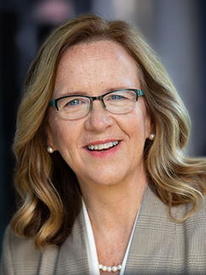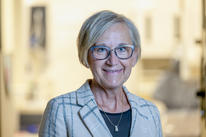Loan forgiveness encourages faculty to stay in academia

A federally-funded grant program is changing the lives of faculty members who pursue academia at the School of Dentistry.
In 2016, Sheila Riggs, DDS, MS, DMSc, chair of the Department of Primary Dental Care, first heard of the Health Resources and Services Administration loan repayment program, which provided five-year grants to schools to encourage faculty recruitment and retention.
“I knew in my heart that it would be a benefit to a set of faculty. The recruitment and retention of great faculty members would mean we could continue to improve the oral health of underserved adults and children in the Upper Midwest,” Riggs recalled. The program provides funds for the repayment of qualified educational loans for selected full-time faculty members within the disciplines of pediatric dentistry, general dentistry and dental hygiene.
Riggs was thrilled at the concept of a loan forgiveness program that would allow the School of Dentistry to remain competitive. “This is a life-changing amount of money for recipients,” she explained.
“As faculty, our salaries are lower than what members of the oral health team could make in private practice,” Riggs continued. “It’s very special that oral health professionals want to dedicate their skills, knowledge and values toward creating the next generation of the oral health team. But our faculty come with huge loans, and it seemed like this would take down some of the barriers and encourage them to keep being faculty members and living out their passions of creating the next generation of the oral health team.”
Riggs and her team were successful in their grant application, allowing them to offer full loan forgiveness to seven faculty members over a five-year period.
Elise Sarvas, DDS, MSD, MPH, was one of the recipients—and was involved in lobbying for the funding through the American Academy of Pediatric Dentistry as early as 2015. “In dental academics, it’s really hard to fill positions and keep people in academics,” she said.
Sarvas, who recently transitioned from the School of Dentistry to Mayo Clinic as a pediatric dentist, saw first-hand the impact of loan repayment programs when she was a resident. “I saw how it made academics a more affordable option for them coming out of school with a lot of debt,” she explained.
Sarvas believes these payments are especially effective for encouraging faculty members to pursue specialties, because of the additional training required. “It’s helpful to have something like this to finance that dream we have of training and teaching the next generation, not only as specialists, but also within general dentistry as well,” she said.
Cyndee Stull, RDH, MDH, DHSc, director of the Division of Dental Hygiene, was another recipient who pursued continued education with the support of loan repayment programs. “It allowed me to pursue my doctoral degree without taking out more loans and without financial stress,” said Stull, who completed her doctoral degree in 2020 while receiving repayment for her Master of Science.
Since 2016, these funds have allowed the School of Dentistry to forgive nearly $700,000 in educational loans.
Both Sarvas and Stull believe strongly in the impact of these programs and see how they have changed their future.
“I’ve seen the impact not only here in Minnesota but also at other universities and programs across the country,” said Sarvas, who serves as Minnesota’s Public Policy Advocate for the American Academy of Pediatric Dentistry, where she lobbies on behalf of policies for children’s oral health needs and dentists’ wellbeing. “Schools are able to recruit new faculty and keep the faculty they have, who have a heart and a passion for academics.”
Stull agreed, saying that loan forgiveness “removes a substantial barrier for faculty.”
“It’s no secret that dental educators would make more money in practice,” she continued. “We have such a shortage of faculty as it is, with the burden of high student loans as a contributing factor. The program helps attract and retain faculty who might otherwise be financially pressured into leaving a profession in education. A loan forgiveness option opens the doors for more dental professionals to consider education as a career.”


